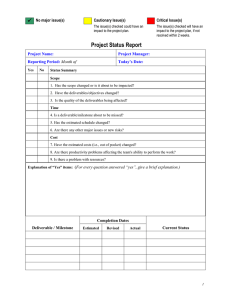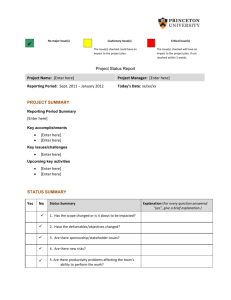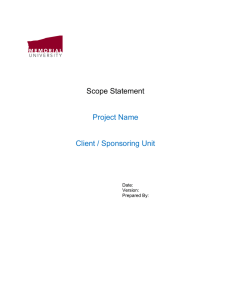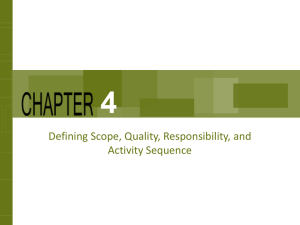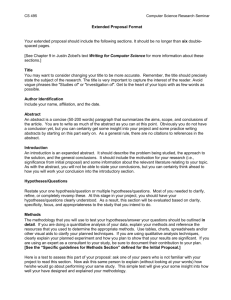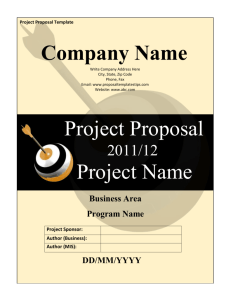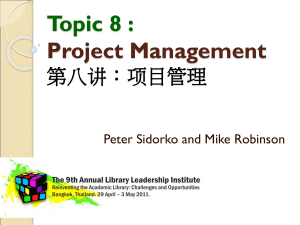Frequently Asked Questions in Project Management
advertisement
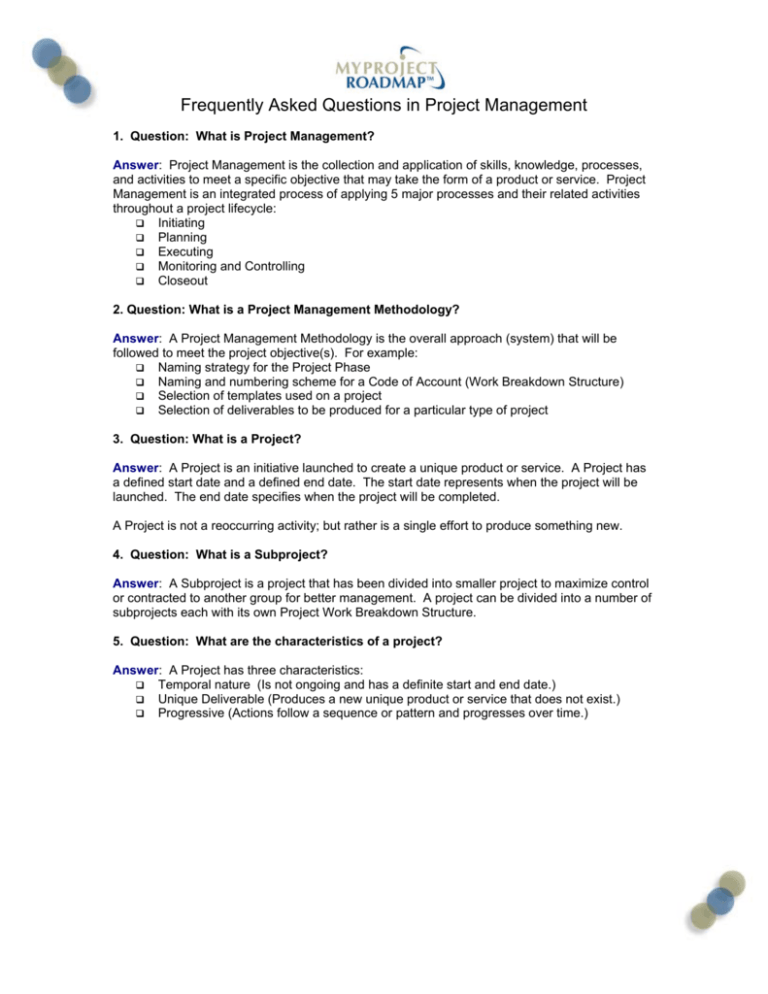
Frequently Asked Questions in Project Management 1. Question: What is Project Management? Answer: Project Management is the collection and application of skills, knowledge, processes, and activities to meet a specific objective that may take the form of a product or service. Project Management is an integrated process of applying 5 major processes and their related activities throughout a project lifecycle: Initiating Planning Executing Monitoring and Controlling Closeout 2. Question: What is a Project Management Methodology? Answer: A Project Management Methodology is the overall approach (system) that will be followed to meet the project objective(s). For example: Naming strategy for the Project Phase Naming and numbering scheme for a Code of Account (Work Breakdown Structure) Selection of templates used on a project Selection of deliverables to be produced for a particular type of project 3. Question: What is a Project? Answer: A Project is an initiative launched to create a unique product or service. A Project has a defined start date and a defined end date. The start date represents when the project will be launched. The end date specifies when the project will be completed. A Project is not a reoccurring activity; but rather is a single effort to produce something new. 4. Question: What is a Subproject? Answer: A Subproject is a project that has been divided into smaller project to maximize control or contracted to another group for better management. A project can be divided into a number of subprojects each with its own Project Work Breakdown Structure. 5. Question: What are the characteristics of a project? Answer: A Project has three characteristics: Temporal nature (Is not ongoing and has a definite start and end date.) Unique Deliverable (Produces a new unique product or service that does not exist.) Progressive (Actions follow a sequence or pattern and progresses over time.) 6. Question: Who is responsible for the project? Answer: The Project Manager is directly responsible for the results of the project. He/She should use the necessary skills, knowledge, and tools to meet the project objective(s). During the early phases of the project, the Project Manager, working with the project team, should be able to: Determine project goals and objectives Determine assumptions and constraints Define and validate product description Determine project requirements Define Project deliverables Estimate and monitor project resource allocation 7. Question: What is a Project Phase? Answer: A Project Phase is a logical grouping of related or dependent activities and their related deliverables. Each Project Phase constitutes a very important milestone in a project. 8. Question: How do I define a Project Phase? Answer: The process to develop a Project Phase naming strategy or standard is dependent on your company’s orientation to project management and the project requirement. A good point of reference is to develop a benchmark using, for example, your industry or business area. The naming strategy for a Project Phase may vary widely based on industry specific standards, technical processes, business activities, or frequency, iteration, of activities to produce a deliverable(s). 9. Question: What is a Milestone? Answer: A Milestone is a symbol that marks a point in time where something will be produced or when an event will occur during a project lifecycle. 10. Question: Is a Project Schedule similar to a Project Management Plan? Answer: No. A Project Schedule is an input to the Project Management Plan. A Project Schedule contains a list of activities, activity attributes, activity duration estimates, resource assignments, planned start and finish dates. For example: A Project Management Plan is the collection of all management plans across all of the knowledge areas in Project Management: Project Integration Management Project Scope Management Project Time Management Project Cost Management Project Quality Management Project Human Resource Management Project Communication Management Project Risk Management The process of the project will be tracked against the Project Schedule. The Project baseline will be compared to the Project Management Plan as the project progresses. 11. Question: What is a critical path? Answer: Critical path is the longest path to complete the project that contains no float by aligning all of the project activities to complete the project. The goal of critical path is to determine the blend of activities that determine the project completion date based on the tasks estimated duration. Critical path uses five variables: Earliest Start (ES) Earliest Finish (EF) Late Start (LS) Late Finish (LF) Duration 12. Question: Can the project’s critical path change? Answer: Yes, the critical path is based on the estimated duration of a series of tasks that determine the longest path to complete the project. Therefore, the project’s critical path is subject to change if there is a change to the number of tasks, duration, or sequencing of those. 13. Question: When do I assess a Risk? Answer: That is a loaded question because depending on where you are in the project the risk assessment activity that you do will depend on what has already been done. An easy way to answer this question is to respond by saying that risks should be assessed throughout the entire project management process. Risks assessment doesn’t happen in a vacuum. Risks are assessed in the context of the project. The process to assess a risk has to be commensurate to the project itself—especially if the project and project manager are internal to the performing organization or external to the performing organization. Risk should always be reviewed at each project review. Risks should be monitored throughout the project lifecycle to determine if and when a risk trigger has occurred and whether the planned contingency plan was effective. 14. Question: What is a Risk? Answer: A Risk is an uncertain event that may have a positive or negative impact on the project objective. If and when it occurs, a Risk can be an opportunity (positive impact) or a threat (negative impact). There are two types of Risks: Business and Insurable. Risks can be grouped into various categories (Functional, Technical, Financial, and etc.) 15. Question: What is an Issue? Answer: An Issue is an unplanned consideration, concept, or circumstance that arises out of a new discovery or discourse that may impact the project objective(s). Typically, an Issue arise out of a concern, dispute between project stakeholders, or discussions. Basically, an Issue is an introduction of new information that warrants discussion or consideration. 16. What is the difference between a risk and an issue? Answer: The difference between a Risk and an Issue is that a Risk is ‘planned for’. As part of the Risk assessment process, a Risk is identified, qualitatively and quantitatively analyzed, and a response is determined and monitored. An Issue is a new consideration that needs to be analyzed before a determination is rendered. Similar to a Risk, an Issue can potentially be an opportunity (positive impact) or thread (negative impact) on the project objectives. 17. Question: What is a Deliverable? Answer: A Deliverable represents a product that is produced as a result of completing one or more activities. A Deliverable is a verifiable element that can be inspected or qualified to determine that one or more activities were performed to complete a process or project phase. Deliverables and their associated activities and processes are grouped into Project Phases. 18. Question: What is more important: Scope, Quality or Cost? Answer: They are all equally important. Whenever a project activity is performed, the project team should reference the Project Management Plan to ensure that the product or service meets the customer’s exception and fulfills a true need—all of which working within budget. Quality should never be sacrified. Scope is managed by the project scope and work breakdown structure. All deliverables produced on the project should be identified in the Project Work Breakdown Structure. The project’s cost baseline should be managed and reviewed regularly to track performance related information to the deliverables produced at each project phase. 19. Question: At what point in the project do I document lessons learned? Answer: A Lessons Learned document can be created at any point of the project. Typically, Lessons Learned documents are created as a result of a change request, defeat or part of the project closeout process. It is a good idea to create the Lessons Learned document as an ongoing activity, similar to Risk assessment, throughout the project lifecycle to ensure that knowledge is captured, communicated, and integrated into the organization. 20. Question: What is Knowledge Management? Answer: Knowledge Management is a process and related activities for companies to cultivate and retain information produced within an organization. The objective of Knowledge management is to enable an organization to achieve business objectives, such as improve quality, produce better products and services, by creating processes and activities to cultivate, retain, and create new knowledge from experiences. 21. Question: How does Knowledge Management fit into a Project Management context? Answer: There is inherent synergy between Knowledge Management and Project Management. Simply, Knowledge Management ensures that a project will be successful if the project team can create new knowledge, based on lessons learned, widely communicate the new knowledge to appropriate stakeholders, and promote an environment of shared learning through knowledge transfer activities. 22. Question: What is a Knowledge Transfer Matrix? Answer: A Knowledge Transfer Matrix is a tool used in Knowledge Management, similar to the Knowledge Flower, to assess and address gaps (skill sets, capabilities, etc) in the organizations. A Knowledge Transfer Matrix provides a roadmap for an organization to align needed skill sets across various business processes against the organization’s staff current skill level. Typically, a Knowledge Transfer process starts with a needs assessment of an organization and is concluded with the tracking of those attained skills within the organization over time. The goal of the Knowledge Transfer process is to empower and enable the organization to become selfsustained and develop innovative ways to harness the power of knowledge within the organization.
